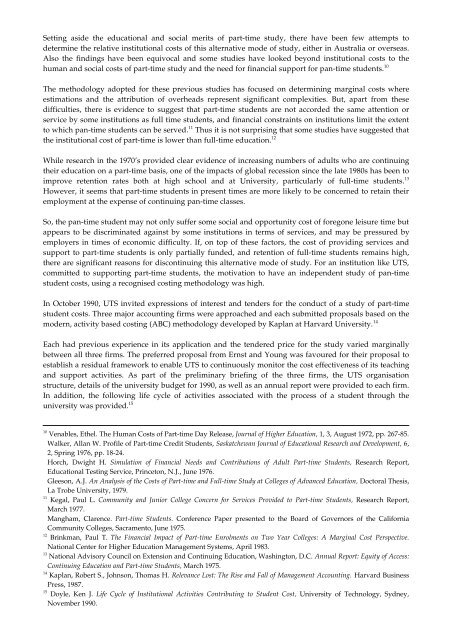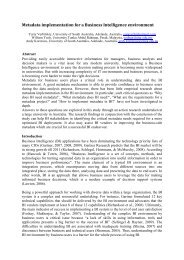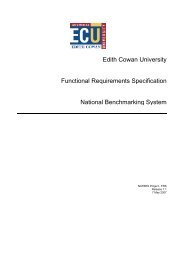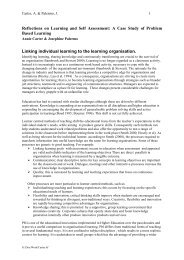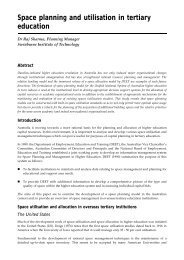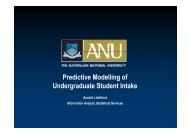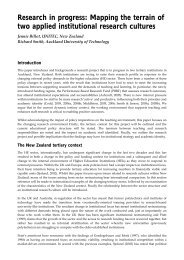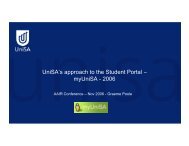Study of student costs using activity based costing methodology - aair
Study of student costs using activity based costing methodology - aair
Study of student costs using activity based costing methodology - aair
You also want an ePaper? Increase the reach of your titles
YUMPU automatically turns print PDFs into web optimized ePapers that Google loves.
Setting aside the educational and social merits <strong>of</strong> part-time study, there have been few attempts to<br />
determine the relative institutional <strong>costs</strong> <strong>of</strong> this alternative mode <strong>of</strong> study, either in Australia or overseas.<br />
Also the findings have been equivocal and some studies have looked beyond institutional <strong>costs</strong> to the<br />
human and social <strong>costs</strong> <strong>of</strong> part-time study and the need for financial support for pan-time <strong>student</strong>s. 10<br />
The <strong>methodology</strong> adopted for these previous studies has focused on determining marginal <strong>costs</strong> where<br />
estimations and the attribution <strong>of</strong> overheads represent significant complexities. But, apart from these<br />
difficulties, there is evidence to suggest that part-time <strong>student</strong>s are not accorded the same attention or<br />
service by some institutions as full time <strong>student</strong>s, and financial constraints on institutions limit the extent<br />
to which pan-time <strong>student</strong>s can be served. 11 Thus it is not surprising that some studies have suggested that<br />
the institutional cost <strong>of</strong> part-time is lower than full-time education. 12<br />
While research in the 1970’s provided clear evidence <strong>of</strong> increasing numbers <strong>of</strong> adults who are continuing<br />
their education on a part-time basis, one <strong>of</strong> the impacts <strong>of</strong> global recession since the late 1980s has been to<br />
improve retention rates both at high school and at University, particularly <strong>of</strong> full-time <strong>student</strong>s. 13<br />
However, it seems that part-time <strong>student</strong>s in present times are more likely to be concerned to retain their<br />
employment at the expense <strong>of</strong> continuing pan-time classes.<br />
So, the pan-time <strong>student</strong> may not only suffer some social and opportunity cost <strong>of</strong> foregone leisure time but<br />
appears to be discriminated against by some institutions in terms <strong>of</strong> services, and may be pressured by<br />
employers in times <strong>of</strong> economic difficulty. If, on top <strong>of</strong> these factors, the cost <strong>of</strong> providing services and<br />
support to part-time <strong>student</strong>s is only partially funded, and retention <strong>of</strong> full-time <strong>student</strong>s remains high,<br />
there are significant reasons for discontinuing this alternative mode <strong>of</strong> study. For an institution like UTS,<br />
committed to supporting part-time <strong>student</strong>s, the motivation to have an independent study <strong>of</strong> pan-time<br />
<strong>student</strong> <strong>costs</strong>, <strong>using</strong> a recognised <strong>costing</strong> <strong>methodology</strong> was high.<br />
In October 1990, UTS invited expressions <strong>of</strong> interest and tenders for the conduct <strong>of</strong> a study <strong>of</strong> part-time<br />
<strong>student</strong> <strong>costs</strong>. Three major accounting firms were approached and each submitted proposals <strong>based</strong> on the<br />
modern, <strong>activity</strong> <strong>based</strong> <strong>costing</strong> (ABC) <strong>methodology</strong> developed by Kaplan at Harvard University. 14<br />
Each had previous experience in its application and the tendered price for the study varied marginally<br />
between all three firms. The preferred proposal from Ernst and Young was favoured for their proposal to<br />
establish a residual framework to enable UTS to continuously monitor the cost effectiveness <strong>of</strong> its teaching<br />
and support activities. As part <strong>of</strong> the preliminary briefing <strong>of</strong> the three firms, the UTS organisation<br />
structure, details <strong>of</strong> the university budget for 1990, as well as an annual report were provided to each firm.<br />
In addition, the following life cycle <strong>of</strong> activities associated with the process <strong>of</strong> a <strong>student</strong> through the<br />
university was provided. 15<br />
10 Venables, Ethel. The Human Costs <strong>of</strong> Part-time Day Release, Journal <strong>of</strong> Higher Education, 1, 3, August 1972, pp. 267-85.<br />
Walker, Allan W. Pr<strong>of</strong>ile <strong>of</strong> Part-time Credit Students, Saskatchewan Journal <strong>of</strong> Educational Research and Development, 6,<br />
2, Spring 1976, pp. 18-24.<br />
Horch, Dwight H. Simulation <strong>of</strong> Financial Needs and Contributions <strong>of</strong> Adult Part-time Students, Research Report,<br />
Educational Testing Service, Princeton, N.J., June 1976.<br />
Gleeson, A.J. An Analysis <strong>of</strong> the Costs <strong>of</strong> Part-time and Full-time <strong>Study</strong> at Colleges <strong>of</strong> Advanced Education, Doctoral Thesis,<br />
La Trobe University, 1979.<br />
11 Kegal, Paul L. Community and Junior College Concern for Services Provided to Part-time Students, Research Report,<br />
March 1977.<br />
Mangham, Clarence. Part-time Students. Conference Paper presented to the Board <strong>of</strong> Governors <strong>of</strong> the California<br />
Community Colleges, Sacramento, June 1975.<br />
12 Brinkman, Paul T. The Financial Impact <strong>of</strong> Part-time Enrolments on Two Year Colleges: A Marginal Cost Perspective.<br />
National Center for Higher Education Management Systems, April 1983.<br />
13 National Advisory Council on Extension and Continuing Education, Washington, D.C. Annual Report: Equity <strong>of</strong> Access:<br />
Continuing Education and Part-time Students, March 1975.<br />
14 Kaplan, Robert S., Johnson, Thomas H. Relevance Lost: The Rise and Fall <strong>of</strong> Management Accounting. Harvard Business<br />
Press, 1987.<br />
15 Doyle, Ken J. Life Cycle <strong>of</strong> Institutional Activities Contributing to Student Cost, University <strong>of</strong> Technology, Sydney,<br />
November 1990.


